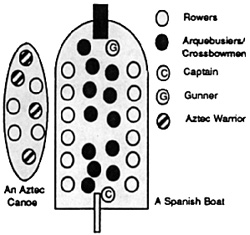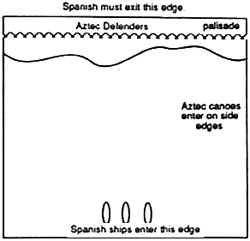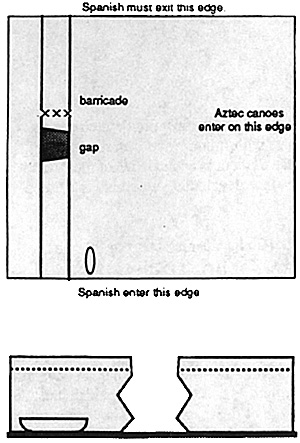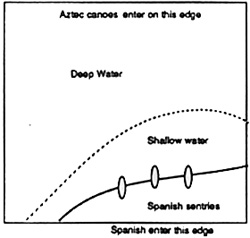When we think of amphibious operations today, we might think of steel gates on specialized landing craft dropping open to disgorge specially trained marines. In the Renaissance, armored soldiers with cumbersome equipment would have to haul themselves over the gunwales of a long boat, but there was still a need for amphibious operations.
When Cortez invaded the Aztec empire in 1520, he succeeded in defeating the Aztec armies in the field, but he could not defeat and take control of the empire until he had captured the capital city, Tenochtitlan. Unfonunately for him, Tenochtitlan was built on a lake, Lake Texcoco. Only four causeways connected the city to dry land. The Spaniards' first expedidon into the city suffered severe casualties while attempting to retreat along broken and guarded causeways. Cortez knew that he had to build boats if he wanted to storm the island city.
Indian allies working with skilled carpenters from among the Spanish sailors built 13 assault boats. They have been described as "sloops," "brigantines,""gunboats," and "launches." We do not know the dimensions of these boats, but we do know that they were built with a rudder, large square sail, and a cannon mounted in the prow. Each ship's complement included a captain, a gunner, 12 rowers, and a mixed group of 12 arquebusiers and crossbowmen. The new boats had to gain control of the lake, in order to perform three main duties: 1) support the Spanish advances along the causeways, 2) assault lake side towns, and 3) cut off supplies to the city.
Lake Texcoco was covered with Indian canoes. The typical canoe was made from a hollowed-out log and would hold 6, 8, or 12 warriors. Approximately half would row and while half would throw javelins or shoot arrows. There were also a limited number of royal canoes, or piraguas, which could hold as many as 40 people. These were also made from hollowed-out trees, and were used to transport nobility.
In the initial stage of the campaign to seize Tenochtitlan, the Spanish captured each of the towns along the lake. The boats woult assault the lake side of a town while the rest of the Spanish force would attack the landward sides, as the Spanish advanced along the causeways, the boats helped the different commands cross breaks in the causeways, and prevented Aztec canoes from showering the causeways with missiles. Naval battles occurred in the middle of the lake, with large numbers of Aztec canoes attempdug to swarm a few Spanish boats. The Spanish won, thanks primarily to their cannons and the mobility provited by the sails.
Eventually, as the Spanish gained control of the lake and began to storm the capital city, the Aztecs developed new approaches to dealing with the assault boats. First, they attacked the Spanish shoreline encampments at night, attempting to capture the boats. Then, they installed sharpened stakes just below the water's surface to snag the boats. Inidally, the boats became stuck the stakes, but the Spanish soon learned that they could break the stakes if they sailed over them at full speed.
Finally, as a last resort, thc Aztecs launched an attack with their best warriors in the large piraguas. They used smaller canoes carrying supplies as bait, then ambushed the Spanish boat that came out to intercept the supply canoes. The entire Spanish crew was killed or wounded, but other Spanish boats arrived and drove off the attackers.
Wargaming the Assault on Tenochtitlan
You don't have to have Aztec and Spanish figures to replay this situation. This scenario could easily be moved to another conflict, whether it is Christians versus Moslems in the Mediterranean, the Swiss and the Burgundians around Lake Geneva, or North American Indians and 17th century English settlers in King Philip's War.
The Boats
 Miniature Figurines sells 15mm and 25mm metal boat models in the "Limeys & Slimeys" series, including longboats and small sailing ships. Several other companies sell the odd boat or
two, and you could always use "toy" boats (overspraying the fluorescent orange color with
brown). One quick and easy approach to shipbuilding is to cut out a boat-shaped movement stand
from bass wood, plastic, or cardboard. Cut a strip about 1/2 a figure high to go around the edge of the stand, forming the boat.
Miniature Figurines sells 15mm and 25mm metal boat models in the "Limeys & Slimeys" series, including longboats and small sailing ships. Several other companies sell the odd boat or
two, and you could always use "toy" boats (overspraying the fluorescent orange color with
brown). One quick and easy approach to shipbuilding is to cut out a boat-shaped movement stand
from bass wood, plastic, or cardboard. Cut a strip about 1/2 a figure high to go around the edge of the stand, forming the boat.
The Spanish boats should be four figures wide and nine figures long, with a small cannon mounted on the front and a rudder in the back. You may want to leave off the sail, as it can be hard to mount, and will make handling the figures difficult. Aztec canoes should be two figures wide and 3 to 6 figures long.
The Rules
15mm Spanish boats move 1/2" for every pair of rowers, with a turn radius of 2", while the canoes move 1" for every pair of rowers, with a 1" turn radius. Double the numbers for 25mm. For simplicity, always consider the Spanish sails to be raised. A wind direction must be established for each battle. Spanish boats moving within 90 degrees of downwind get a 3" movement bonus, and boats within 45 degrees of downwind get 6" extra.
Ship to ship combat was mostly missile fire. Rowers are assumed to be sitting, and tberefore in Soft Cover, unless otherwise indicated. For melee, use the siege rules in the back of WRG 1420 1700 or Medieval Tactica, both of which allow for figure to figure combat. No more tban half the occupants of a canoe can stand up without the canoe tipping over. Everyone can stand up in a Spanish boat.
Weapons thrown from a sitting position have their range halved, and their effectiveness reduced by 1 (WRG). A Spanish ship moving at full speed (6 rower pairs x 1/2" = 3" (6")) which strikes an Aztec canoe on the side with its prow will sink the canoe. Treat figures attacking from one boat to another like men on assault ladders. Anyone thrown off goes into the water. Figures that go into the water are not recovered during the battle. Rowers can either row or fight. They cannot do both in the same turn.
Spanish rowers are LI swordsmen. They were mostly sailors, and it is not clear whether they had shields. They can use their oars as clubs, but the oars will undoubtedly break during combat. The arbuquebusiers and crossbowmen were present in approximately equal numbers, and should be considered MI. Cortez specifically ordered all the metal body armor to be given to the troops attacking down the causeways. The gun should be an ultra-light gun. Everyone on a Spanish boat should have B class morale, including the gunner and captain.
Aztec rowers are ordinary LI, D or C class, with javelins. Most of the fighters in a canoe should have missile weapons, since opposing boats rarely came into contact. You can use any warriors from an Aztec army list for the rest of a canoe crew. Remove canoes which become empty.
Scenarios
Assume each map is 2'x 2' (4' x 4') square.
Cross-lake Assault
 The Spanish must cross the lake and assault a town. The Aztecs must divide their forces between the land and the water. The Spenish have three boats with full crew.
The Spanish must cross the lake and assault a town. The Aztecs must divide their forces between the land and the water. The Spenish have three boats with full crew.
The obstacles count as palisades. The Spamsh must defeat the defender and exit 1/3 of their force off the north edge of the map to win. The land is just above water level, and vulnerable to cannon.
The Aztec force is equal in point size to the Spanish (Count Spanish boats as 20 points each, and each as a separate command. Aztee canoes are free.) The Aztecs receive as many 6,8, or 12 man canoes as they need to carry their forces, and all of the canoes but one must be full. Half of the Aztec "navel" force must be rowers. No more than 2/3 of the other half can be Knights. Aztoc crews can land their canoes and fight on foot. They win by stopping the Spanish from achieving their victory conditions.
The battle can be scaled down by reducing the Spanish force to only 1 or 2 boats and reducing the Aztec force to match.
Causeway Battle
 A Spanish force is driving up a defended causeway, supported by one boat. They start with a
full boat force and a 200 point WRG causeway force. Members of this force can be anything
from an early 16th century Spanish army list, including cavalry, cannons, and war dogs.
A Spanish force is driving up a defended causeway, supported by one boat. They start with a
full boat force and a 200 point WRG causeway force. Members of this force can be anything
from an early 16th century Spanish army list, including cavalry, cannons, and war dogs.
The Aztecs start with 400 point force, which they can deply on the causeway or in canoes. They have broken the causeway and barricaded one end of the break. The barricade counts as miscellaneous obstacles such as wagons. No more than 1/3 of the forces can be Knights, and half the force in canoes must be rowers.
The causeway is 8 figures wide. The break is 2" (4") wide. The causeway is 3 figure heights above the water. The bottom of the break is dry rubble at water level and counts as rough ground. Missile attacks from the boat and canoes against the causeway count as firing against hard cover. Occupants "n:~ of the boat and canoes can only climb the causeway where it is broken. The sides are too smooth to climb. Use medieval scaling rules. The cannon in the Spanish boat cannot fire at the top of the causeway unless it is at least 8"(16") away.
To win, the Spanish must cross the break in the causeway, storm the barricade, and exit off the other end of the causeway with at least In of the original causeway force, without losing the boat.
Aztec Night Raid
The Spanish are camped on shore, with three boats pulled up out of the water. The crews are sleeping nearby, along with 24 HI swordsmen. 8 swordsmen are on sentry duty anywhere on land or in the boats. The cannon are loaded. The Spanish are sleeping in their armor. Use night visibility rules.
The Aztecs move first, keeping track of their movement on a map until they ean be seen by a sentry. From that turn on, the Spanish wake up at the rate of 12 figures per turn. The Spanish player can choose which figures awaken first. Awakened Spanish enter the map edge anywhere there is land. Any Spaniard may discharge the boat cannon the first time, but only a gunner can fire it subsequently.
 Men in shallow water move at half speed. Combat is not affected. Any figure that does
not fight in a turn can instead grab ahold of a boat. Six figures can pull a boal 1/2" (1") per turn. If both sides have their hands on a boat, subtract the larger group from the smaller group. Boat movement points calculated each player turn.
Men in shallow water move at half speed. Combat is not affected. Any figure that does
not fight in a turn can instead grab ahold of a boat. Six figures can pull a boal 1/2" (1") per turn. If both sides have their hands on a boat, subtract the larger group from the smaller group. Boat movement points calculated each player turn.
If a boat is pulled out of the shallow water zone, everyone holding on to the boat jumps in. If everyone in a boat is killed, the boat does not move. No figure can move into deep water. The Aztecs win if they can get out of sight of the Spanish with one boat. This scenario can be scaled down like the first scenario, reducing the forces involved by 1/3 or 2/3.
The Final Effort
On the first turn, a 12 man Aztec canoe with 6 rowers and supplies moves first, crossing the middle of the map from Ieft to right, without turning, even when attacked. As soon as one canoe exits the map, another one enters from the opposite side. The Spanish player must find and board one of these canoes before four of them cmss the map. Otherwise the Spanish player loses. A Spanish boat with a full complement enters from the bottom of the map on the first turn. On any turn after a supply canoe is fired on or boarded, three Aztec piraguas enter from either the left or right side of the map.
The large canoes are three figures wide and 12 figures long. Up to one third of the entire crew can be Knights. Each large canoe should include a leader of high rank and one canoe may have a religious contingent. The Aztecs win by eliminating the Spanish crew and capturing the boat.
Optional Rules
Stakes
At the end of each Spanish boat move, each boat must roll a d6. A roll of a 6 means that the boat is stuck in place, unless it was moving at least 4.5" (9") (full rowing speed and half wind, or half rowing speed and full wind.) Stuck Spanish ships cannot move. Boats which hit stakes at the indicated minimum speed break the stakes. No stake die roll occurs for one turn after a group of stakes are broken. (Optional rule: reduce the stake breaking speed to 3"(6").)
Alternate Stake Rules
The Aztec play secretly marks five areas on a map with 2x2" (4x4") bunches of stakes. He notifies the Spanish player when a Spanish boat has hit the stakes. Rules for breaking the stakes still apply.
Different cannon
The Spanish used a variety of small cannons. For play balance, or after paying the extra points, up to half the Spanish boat cannons can be treated as small bombards.
Wind
You can add your own rules for causing the wind to change direction, start and stop, or even change strength.
Campaign Rules
The game Cortes: Conquest of the Aztec Empire in issue # 20 of Command Magazine makes an excellent campaign game on which to base individual figure battles. Whichever side controls a lake area at the end of a battle recovers 1/3 of the figures in the water. Set a maximum limit on the supply of Aztec canoes.
Back to Saga #49 Table of Contents
Back to Saga List of Issues
Back to MagWeb Master Magazine List
© Copyright 1995 by Terry Gore
This article appears in MagWeb (Magazine Web) on the Internet World Wide Web. Other military history articles and gaming articles are available at http://www.magweb.com